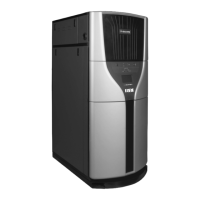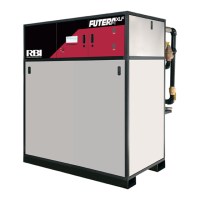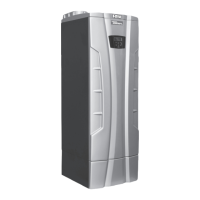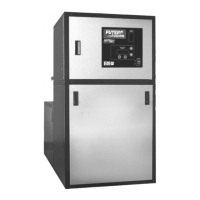OPTIONAL FEATURES HeatNet Control V3
Page 60
For Ametek Blowers, the minimum signal to
control the blower will be less than 20%, but
the display % will be equal to the turndown %
of the boiler. The signal sent to the Ametek
blower is 0-20VDC, so the VDC reading will
need to be divided by (2) to get the modulation
% sent to the Blower. The Ametek blower also
has a menu located at: SETTINGS: BOILER:
BLOWER. This menu allows the Acceleration,
Deceleration, and Soft Start Values to be set for
proper operation of the Blower.
For direct fire applications (sending 0-10 VDC
from a BMS), the 0-10 volt control signal is
proportional to the output. Such that: 1 volt will
track linearly by 10%. So, 1v=10%, 2v=20%,
3v=30%, 4v=40%... The control signal will still
be limited by the turndown and the 4-20 mA
INPUT menu. This means that the 1v signal
will have no effect on a 5:1, 20% boiler. A ~2v
signal will start the 5:1 boiler.
Setpoint Control functionality can be implemented remotely
using the 4-20 mA input. This function translates a 4 to 20
mA control signal to a setpoint mapped from 50F to 220F.
The feature is enabled in the SETPOINTS menu as:
SETTINGS: SETPOINTS: SETPT SOURCE 4-20 mA.
SETTINGS: 4-20 mA INPUT: CHANNEL MODE. Also,
when selecting; SETUP: SETPOINTS: SETPT SOURCE and
selecting 4-20 mA, the 4-20 mA INPUT menu will be
automatically entered.
You may select the current at which the boiler will start. It is
adjustable from 3.7mA to 5mA. Hysteresis of .1mA is always
in effect. So, if the starting mA = 4.10 mA the boiler will start
when the control current applied achieves this value of
4.10mA. The boiler must drop .1mA below this to turn OFF,
in this example 4.00mA. This hysteresis value is not
adjustable.
When using the 4-20 mA setpoint control, a band may now be
set at which the 4-20 mA signal will operate over. The lower
setpoint is defined as 4mA SETPOINT and the upper setpoint
is defined as 20 mA SETPOINT. The 4 mA SETPOINT is
linked to the BOILER START x.xx mA where this starting
current is the lower setpoint. So, if we set the 4 mA
SETPOINT to 130F and the 20 mA SETPOINT at 180F we
will have established the band. Once a starting control current
of BOILER START 4.1mA is applied, and the 4-20
REMOTE ENABLE INPUT is closed, the boiler will start and
the setpoint will be set to 130F. If a control current of 10 mA
is applied the boiler will track on a linear slope towards the 20
mA SETPOINT settling at a SETPOINT of ~149F. As the
current increases to 20 mA, the SETPOINT will indicate
180F. The Default setting is 4 mA SETPOINT: 50F, and 20
mA SETPOINT 220F for backwards compatibility with the
older version.
Anytime a new firmware version is uploaded to
the control, these values return to these
defaults.
If using the direct modulation mode by applying a 4-20 mA
current, only the BOILER START x.xx setting applies.
The 4-20 mA input can be set to HIGH PRIORITY. This is
done in menu: SETTINGS: 4-20 mA INPUT: CHANNEL
MODE. This allows a member boiler to be taken offline and
directly modulated by an external control. If the Master is
using it for heating and the 4-20 mA is set to HIGH
PRIORITY, an external control can now output a 4-20 mA
signal which will take over the boiler’s fire rate. This is
typically used for DHW control.
Setpoint Priorities
Changing the setpoint can be done in many ways. If a higher
level setpoint control is lost, the next level setpoint control is
used until the System Setpoint is loaded. The setpoints are
prioritized in the following order:
1. 0-10V, 4-20 mA Setpoint Control
2. BMS, Modbus Setpoint
3. Outdoor Reset Setpoint
4. Menu’s System Setpoint
Any Setbacks that are active are then applied.
Circulator Pump Options
There are provisions for a system pump(s) and a local pump.
This is to allow for primary/secondary loop configurations.
The system circulator pump is implemented using the K4,
K13 RELAY and normally open contacts at J16 SYSTEM
PUMP 1 and SYSTEM PUMP 2.
The pumps require motor contactors to
isolate the on-board relay contacts. The on-board relays
should never be used to energize large pumps directly. Figure
45 illustrates the connections without contactors. The system
circulator pump is supported by (2) modes and special
features.
1. The first mode will allow the circulator pump to remain
on, unless the control’s outside high air temperature
setting has been met when using OUTDOOR AIR
RESET.
2. The second mode will allow the circulator pump to be
turned on whenever there is a call for heat (any control
input). This mode will stop the circulator pump when the
call for heat is lost and the pump post purge time has
been satisfied.
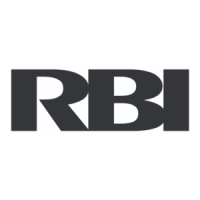
